

|
WRECKCHASING.COM:
Presented by Pacific Aero Press
Product ReviewsWreckchasing.com presents the following reviews of aviation and aviation archaeology related products and services for the education of our visitors. |
|
|
|
|
|
|
 |
Aircraft Wrecks (in the Mountains and Deserts of California) 1909-2002By Gary Patric Macha and Don Jordan6 inches by 9 inches, softbound, 506 pages, 355 black and white photos, plus maps. $34.95 Review by Nicholas A. Veronico |
This book was written for aviation archaeology enthusiasts, hikers, and arm-chair adventurers. However, it should be standard reading for all future and current aviators.
Aircraft Wrecks in the Mountains and Deserts of California 1909-2002 details the final fates of more than 1,300 aircraft littering the state. Previous volumes of this book were valuable, database type listings of aircraft mishaps. This updated, third edition has retained much of the database information, but now includes "Detailed Accounts" of a number of high-profile crashes and stories of how the authors reached the sites. The book is listed by geographical region; the authors having divided California into 15 separate sections. Within each region, crashes are listed by date, aircraft type, cause, and final fate of the occupants. The listings cover the full range of aircraft, from private, military, and commercial types to helicopters, drones, and experimental planes.
One common theme throughout the book is that many of these crashes are the result of poor go/no-go decisions, or in flight judgment calls that turned bad. Every current and potential pilot should spend a weekend and hike to one of these sites. It is certainly sobering to stand in the middle of what once was a flying machine, and to see only twisted pieces of aluminum. Each aircraft listing in this book is a memorial of sorts to those who perished.
Searching for historical aircraft crash sites is becoming an accepted weekend activity, and is gaining in popularity every day. Almost every major aviation museum participates in the hobby in one way or another. For example, the F4U Corsair on display at the Museum of Flight in Seattle, Wash., is a prime example of aviation archaeology. In this case, a team of researchers tracked the crash site through documentation, and then they set out to locate the aircraft. Finding "The Lost Squadron" on the Greenland icecap and the recovery and restoration of the P-38 Glacier Girl is a prime example of how intriguing and valuable aviation archaeology has become to preserving our aviation history.
This title is available from available from the publisher: Infonet Publishing (949)458-9292 or www.infonetpublishing.com
 |
RaceplaneTECH: Griffon-Powered MustangsA. Kevin Grantham and Nicholas A. VeronicoWarbird Aero Press. 2000, 8.5"x11", softbound, 100 page book includes 200 B&W photos plus 10 color color photos. $16.95 Review by Scott Germain |
Unlimited air racing is a difficult, "inside," subject to write about. The number of people writing about it versus those whom really know what is going on is lopsided. In addition, the number of publications dealing with air racing is low. Fans must dig for what does get published, and we all wait impatiently for the next book, web site update or magazine with Reno coverage.
Aviation authors Kevin Grantham and Nicholas Veronico - long time air racing writers as well as noted aviation writers - have written the first volume of RaceplaneTECH. Published by Specialty Press, Griffon Powered Mustangs is the first volume in a technical series of books taking a close look under the skin of unlimited air racers. These books follow the proven formula of their WarbirdTECH and AirlinerTECH series. Each book is a soft cover with 100 pages and approximately 135 photos and diagrams. Four pages of color photos occupy the center of the book.
RaceplaneTECHvolume one concentrates on the three unlimited racers that have used the Rolls Royce Griffon engine. Although the title is Griffon-Poweed Mustangs, one must give some leeway due to the fact that Miss Ashley II was not really a Mustang at all. Close enough, though!
The book begins with a history on the development of the Griffon, then moves on to the N7715C airframe that became The Red Baron. The authors interviewed various people associated with the racer and this information is passed on to the reader. Pete Law, Randy Scoville, Chuck Hall, Gunther Balz and Steve Hinton all lend first hand recollections and technical data regarding The Red Baron. Modification and race information is also included.
The book then moves on to Don and Bill Whittington’s World Jet Griffon-powered Mustang. Like the Red Baron chapter, Don Whittington gives first hand quotes as to how the aircraft was created and how it raced. It’s the shortest chapter in the book, but then again, this racer has garnered the smallest amount of attention of the three aircraft portrayed in the book. Great black and white photos accompany this chapter that will be of great aid to the modeler or historian.
The final chapter is devoted to Miss Ashley II, Bill Roger’s purpose-built racer. Utilizing a custom-built Mustang fuselage, Lear 23 wings and horizontal, and a Griffon 58 for power, this racer really couldn’t be classified as a Mustang at all. However, including Miss Ashley II in this book makes sense with its Griffon engine.
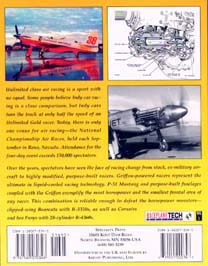 The story on MA2 is well told, with much of the story coming from interviews with Bill Rogers himself. The reader will come to understand the inner workings of this aircraft, and the modifications made to get more speed out of her. A race history and a short note on the demise of MA2 closes the book.
The story on MA2 is well told, with much of the story coming from interviews with Bill Rogers himself. The reader will come to understand the inner workings of this aircraft, and the modifications made to get more speed out of her. A race history and a short note on the demise of MA2 closes the book.
There are other nuggets buried within the covers of RaceplaneTECH: Griffon-Powered Mustangs. A two page spread on Vendetta is published, along with another one page spread on the first Griffon powered racer; a Spitfire Mk. XIV. There is also an essay on the NACA duct technology that Miss Ashley II used for her induction and radiator cooling systems.
Overall, Grantham and Veronico have hit the nail on the head with this book. Obviously, the material they were able to include was limited by the approximately 13,000 words they had to work with. There are deeper stories within these racers, but this book is a solid first step in the right direction. Great job to Grantham and Veronico, and a special kudos to Specialty Press for recognizing the need for more air racing books.
Are there any drawbacks to this title? Yes... We need more of it.
Visit Scott Germain's website at Warbird Aero Press
This title is available from Pacific Aero Press. Order here.
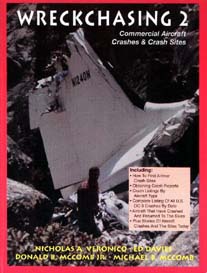
|
Wreckchasing 2: Commercial Aircraft Crashes & Crash SitesNicholas A. Veronico, Ed Davies,Donald B. McComb JR., Michael B. McComb World Transport Press. 1996, 128 pages, 128 black and white plus 11 color photos and illustrations, 8 1/2 by 11 inches, soft bound, Sold Out Review by Dan Thomas Nelson |
They call themselves "Wreck Chasers," and they specialize in a new breed of adventure. Their skills are myriad, from looking up facts in libraries, to trekking across deserted hillsides in search of the proverbial needle in a haystack. Their goal is to find lost and forgotten airplanes, whose airborne lives came to a disastrous finish on some of the most barren, or hidden, real estate known to man. Fortunately, for the rest of us, some wreck chasers are also skilled writers, and they enjoy regaling us with tales of their exploits.
Four of the best have published a new volume of stories entitled Wreckchasing 2: Commercial Aircraft Crashes & Crash Sites. Whereas the first book in the series only covered mostly military aircraft (a British Commonwealth Pacific Airlines DC-6 and Pan Am Martin M-130 were the only airliner stories), the new work looks at a host of airliner accidents through the years. From the famous to the obscure, the book contains a wealth of stories from aviation's dark side.
A typical chapter explains what happened to cause an accident using government investigation reports and old news clippings. Readers then follow the wreck chasers as they track down leads to find the wreckage, often slogging through mud, or drinking gobs of canteen water under a blazing sun. The Wreck Chasers' Law quickly becomes apparent: If wreckage is easy to find, there won't be any left when you get there.
One chapter concerns the famous mid-air collision over the Grand Canyon in 1956, involving a TWA Constellation and a United DC-7. Substantial pieces of wreckage are still there, for hearty souls who can brave a multi-day hiking and rafting expedition. As in all chapters, there are numerous photos showing the airplanes before the accident, and the wreckage at the site today.
Another notable accident profiled is the TWA DC-3 that crashed into a sheer rock face shortly after departing Las Vegas in 1942. Everyone on the full flight was killed instantly, including Carole Lombard, the famous actress and wife of actor Clark Gable. For a wreck chaser, the location provides a strenuous hike, a fabulous view of the Las Vegas valley, tons of vintage wreckage, and a haunting perspective on a loss that was felt throughout the country.
Some other accident covered include a Western Air Express Fokker F-10 in 1930; a Robin Air Lines C-46 in 1952; a United DC-6 in-flight fire and crash in 1947, which led to the grounding of all DC-6s; the mid-air collision of an Air West DC-9 and a Marine Corps F-4 in Southern California in 1971 - including an interview with the sole survivor; and many others.
An introductory chapter explains basic research techniques, and an appendix gives dates and general locations for hundreds of crashes. A section entitled "Ill-fated Airliners" shows before-photos of various airplanes that later crashed, including the Pan Am "Lockerbie" 747, the American DC-10 at Chicago, and the China Airlines 747-400 that ran off the end of the runway at Hong Kong.
For those who desire to get into wreck chasing themselves, or for those who just enjoy sitting back and reading a good yarn, this book can't be beat.
This title is sold out.
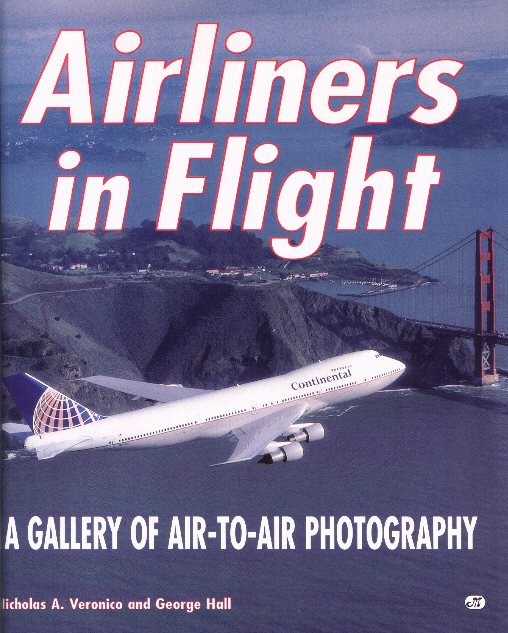
|
Airliners in Flight:
Nicholas A. Veronico and George Hall. |
In the final chapter of Airliners In Flight, co-author George Hall is asked if he has a "Favorite shot." He does, and it is incredible. The reader however, may find it extremely difficult to choose a favorite from the many extraordinary color photographs in this new book.
Former Airliners magazine Editor Nicholas A. Veronico and, photographer to the airline industry, George Hall, have pooled their talents to produce a lavishly illustrated chronicle of the modern airliner that begins in the factory and ends in the "Boneyard." The chapter on the making of an airliner poignantly begins in the Long Beach facility of the Douglas Aircraft Company. It features the MD-90, the last new aircraft type produced by the famous plane maker before its recent acquisition by Boeing. The story line of the conception, building and testing of the MD-90 is accompanied by photographs that range from those taken on the shop floor, to air-to-air shots of the graceful airliner in flight.
The second chapter, entitled "A Day in the Life of a Jetliner," moves interestingly from flight planning to take off, through the flight and landing of a typical, modern passenger airliner. The penultimate chapter fast forwards to the end of the life of an airliner, consigned to the boneyards of the arid desert of Arizona. Tail-less Boeing 707s that will never fly again, jumbo jets in the colors of fallen airlines that are awaiting new owners, even an aged DC-3s. The story of the function of the boneyards is well told, and dramatically illustrated.
The photography throughout this book is extremely well done, particularly the many air-to-air shots of a variety of aircraft types. Well-chosen beautiful backgrounds, enhance dramatically posed aircraft, in coats of many colors. The final chapter lets the reader into the secrets of "How the Pro's Do It," describing how the authors contrived and planned to be in the right place, with the right equipment, at the right time. Two thumbs up for an airliner book with a new twist.
This title is available from Pacific Aero Press. Order here.
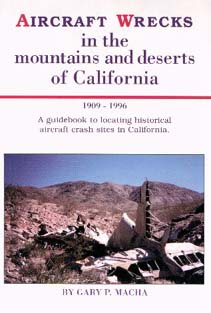
|
Aircraft Wrecks In The Mountains And Deserts of CaliforniaBy Gary P. MachaInfo Net Publishing, Dana Point, California. 1997; 214 Pages, 90 black & white photos/maps, softbound, $19.95. Review by Nicholas A. Veronico |
Aircraft Wrecks In The Mountains And Deserts of California is a comprehensive listing of crash sites covering all types of aircraft. Macha has divided the state into 15 regions; each is also a chapter, listing crashes by date, aircraft make and model, registration, location, and any notes about the site. Appendices list other aircraft archaeological resources, organizations and associations involved with aviation history and archaeology, as well as a detailed four-page form to document and map a crash site.
More than 1,200 crash sites are detailed in this volume, ranging from antiques such as a deHavilland DH-4 and Lockheed Vega to today's modern Cessnas, Pipers, and Beechcrafts. Military enthusiasts will be amazed at the photos of crashed F-4 Phantoms, Consolidated B-24s, and North American B-25s. Airliner buffs will find a treasure trove of information including listings for a Western Air Express Fokker F-10A, New Standard Airlines Fokker Tri-motor, Pacific Air Transport Boeing 40B, numerous American, United, and Western Airlines DC-3s, DC-4s, and -6s of various airlines, as well as the Air West DC-9.
No single book can describe how to get to each aircraft crash site, thus with the date, location, aircraft type, and registration information provided, a dedicated wreck chaser can find any crash listed in this volume.
Aircraft Wrecks In The Mountains And Deserts of California is highly recommended for aviation archaeology enthusiasts, students of aviation safety, and historians alike.
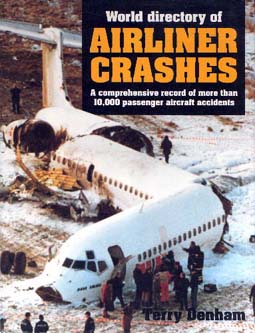
|
World Directory of Airliner CrashesBy Terry DenhamPatrick Stephens Ltd. 1996, 320 Pages, 14 black & white illustrations, 8 1/2 by 11 inches, hardbound, $29.95. Review by Ed Davies |
This title is packed with a comprehensive record of more than 10,000 passenger aircraft accidents from 1906 through 1995. Coverage includes almost all civilian transport-type aircraft capable of carrying eight or more passengers that were written off after incidents in the air or on the ground.
The first chapter covers the period 1906 through 1939, with the remaining chapters allocated to each of the following decades. Crashes are listed in date order, using the British style of Day/Month/Year. This is followed by the aircraft type, manufacturer's serial number, and the operator at the time of the incident. Very brief details of the event, the location, and a listing of the number of fatalities and survivors complete the line for each accident.
Were this not enough, the author then lists these same crashes by aircraft type in Appendix "B," sorted alpha-numerically by registration, with the date of the incident listed alongside. Appendix "C" provides another cross reference, this time sorting the operators alphabetically, and listing their incidents by aircraft registration and date. Other appendices list crashes with no known date, civil types in military use, and nationality prefixes. This directory is the result of 27 years of unbelievable diligence on the part of the author. One's first reaction on receiving this book is to look for that obscure crash that only you know of. Inevitably, Airliner Crashes will have it covered.